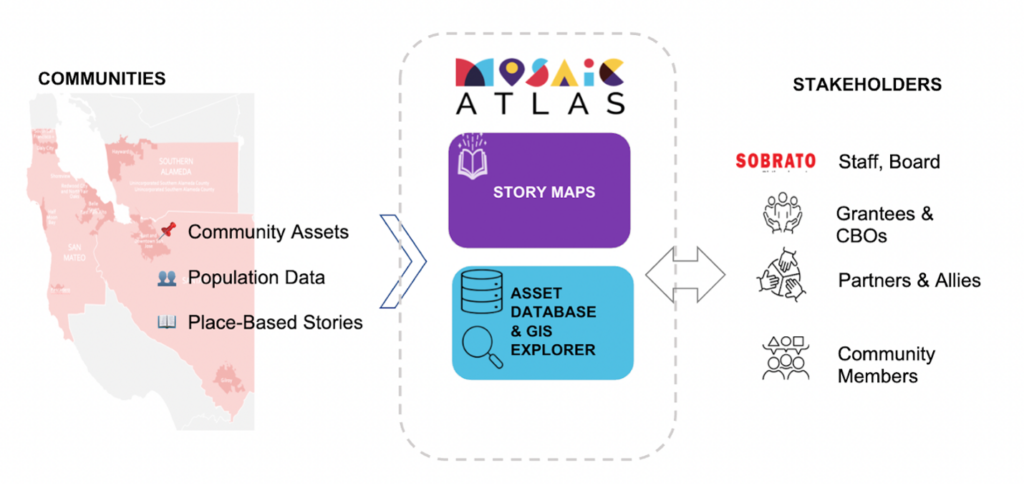
Grantee Spotlight: Mosaic America
Mosaic America: Mapping Communities and Building Bridges Through Art and Storytelling
“At Mosaic America, we believe belonging grows when people feel rooted in place, connected to each other, and free to shape a shared future without giving up their identity or culture.”
Sobrato grantee and partner, Mosaic America is a nonprofit that strengthens social cohesion and belonging across Silicon Valley’s diverse communities through intercultural, co-created art, and dialog. Our thanks to co-founder and President of Mosaic America, Usha Srinivasan, for providing an overview of her organization’s work and how our missions align.
Q: How did Mosaic America connect with The Sobrato Organization?
A: I first met Camille Llanes-Fontanilla during her time at SOMOS Mayfair. After she transitioned to Sobrato, I reconnected to share Mosaic’s mission and programming strategy. Our approach—mapping community assets, bridging across differences, and cultivating belonging to place—resonated with Sobrato’s place-based focus. Camille introduced me to John Matthew Sobrato, who saw the potential of the Mosaic Atlas and Story Maps as tools to ground learning in community strengths. When Sobrato later issued an RFP to identify learning partners, we applied and were selected. As part of the PMEL initiative, Mosaic will contribute qualitative insights through Story Maps and the Mosaic Atlas, ensuring that community voices, traditions, and lived experiences are visible and valued alongside quantitative data.
Q: What is the Atlas?
A: The Mosaic Atlas is an interactive platform that reveals the richness and complexity of Silicon Valley’s communities. It combines a database of community assets—people, places, organizations, and events—with an explorer that lets users navigate them, and Story Maps that bring neighborhoods to life through residents’ voices and histories. At its core, the Atlas is built on the belief that every community is rich in assets. By recognizing and uplifting those assets, we can strengthen cohesion, foster exchange, and design strategies and programs that are truly rooted in community strengths.
Q: You said a Story Mapping feature is part of the Atlas. Can you explain?
A: Story Maps are interactive, place-based narratives that combine maps, images, and voices to tell community stories. They are designed to empower neighborhoods, cultural groups, and movement leaders to uplift their own histories, always centering the voices of those whose stories are being shared. We gather stories through community-based research and present them in engaging formats that connect people to place and preserve perspectives for the future.

Q: What exactly is your work with TSO?
A: As one of Sobrato’s PMEL learning partners, Mosaic brings a distinct focus on place-based community voice and assets. Our role is to ensure that the perspectives, strengths, and lived experiences of communities are visible and valued.
Through the Mosaic Atlas, we combine asset mapping—detailed research and surveys that identify people, organizations, events, and cultural anchors in each community—with Story Maps that document narratives of place. This work highlights assets that are often overlooked, surfaces local themes, and uplifts voices that might not otherwise be heard in traditional evaluation processes.
By sharing these insights, Mosaic helps Sobrato staff, grantees, and partners see communities through their own strengths and stories. Ultimately, our contribution ensures that the Silicon Valley Program’s learning process is not only data-driven, but also rooted in place, culture, and community experience.
Q: How do you approach working with communities?
A: Mosaic starts by identifying community assets—people, organizations, cultural anchors—and then works collaboratively with them to strengthen the relational fabric across a place. Our focus is on mutual benefit: building the connections and trust that create the cohesion needed for collective action. When that fabric is in place, external resources or expertise can be invested more strategically, reaching the right entities and initiatives to maximize impact. This aligns closely with Sobrato’s place-based strategy, which values local strengths and community voice. We’re excited to partner with them because it means our work can help ensure their investments are deeply rooted in community priorities.
Q: Why do you see arts and culture as essential for building belonging and driving social change?
A: Silicon Valley is one of the most culturally diverse places in the country, which means it is also profoundly complex. The old “melting pot” idea of assimilation doesn’t reflect today’s reality—nor should people have to give up any part of their identity to belong. The challenge, and the opportunity, is to build the capacity for communities to embrace that complexity and thrive within it.
That’s where arts and culture come in. Cultural diversity, especially when it happens rapidly, can be a source of division, but we believe it can also be a source of strength. Artists and culture bearers are natural ambassadors: they hold social capital within their own communities and can build bridges across differences. At Mosaic, we bring them together to co-create shared cultural experiences in public spaces. These moments help people overcome fear or hesitancy, see the common threads that connect us, and begin to imagine a shared future where everyone belongs.
Art has always been central to social movements. From protest songs to murals to performance, it animates change by touching hearts as well as minds. Art creates shared experiences that inspire courage, strengthen solidarity, and help movements reach broader audiences. At Mosaic, we see our work in this tradition—using culture not only to foster belonging, but also to spark the imagination and momentum needed for lasting social change.

Q: How do you view the concept of American identity?
A: For too long, American identity has been defined through a narrow lens, with people outside the dominant culture treated as “hyphenated Americans” waiting to become “real Americans.” That assimilation model doesn’t reflect today’s diversity—nor should it. At Mosaic, we believe American identity should be rooted in shared values like freedom, justice, and belonging, while fully embracing the distinct histories and cultures that make up this country.
Just as important, we see identity as deeply place-based. Wherever people live—regardless of origin, ethnicity, or documentation status—they deserve to feel that they belong, and that it is their responsibility, alongside neighbors and local organizations, to create a community of belonging for all. If every community embraced this place-based vision, America itself could be reimagined as a true mosaic: a nation where everyone belongs, not by assimilating, but by contributing their full selves to the shared fabric of place.
*Under Usha’s leadership, Mosaic has delivered programming in six Bay Area cities featuring over 250 artists from over 30 artistic traditions and reached an audience of over 40,000. She is the visionary behind Mosaic Atlas - an interactive explorer of over 120 culturally distinct communities in Silicon Valley. Prior to founding Mosaic America, Usha spent 15 years in various product management roles in Silicon Valley hi-tech companies. She holds an MS in Electrical Engineering from Rensselaer Polytechnic Institute and an MBA from Stanford University. Usha is a Senior Fellow at the American Leadership Forum Silicon Valley. She is among 101 changemakers featured in A Human Atlas of Silicon Valley released in 2023 and serves on the Board of Californians for the Arts and California Arts Advocates.